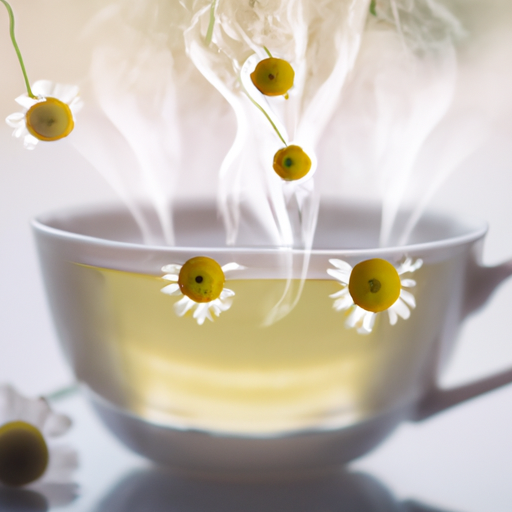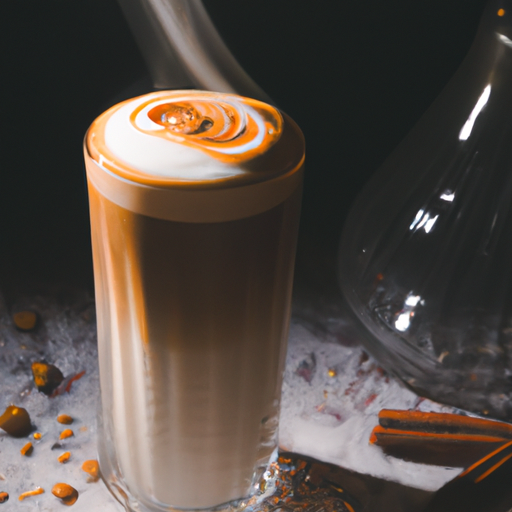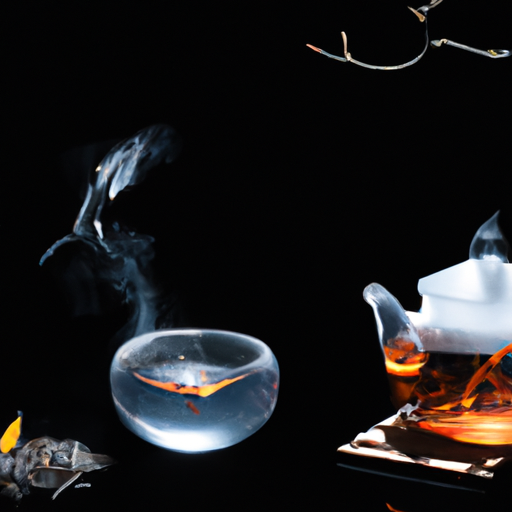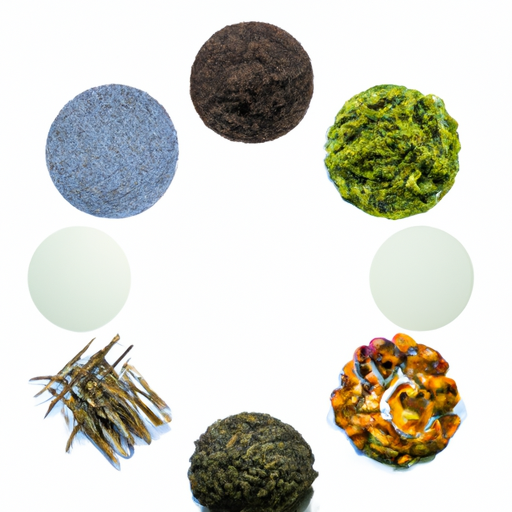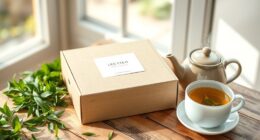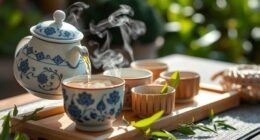As I sat on my porch, sipping a warm cup of chamomile herbal tea, I couldn’t help but marvel at the soothing effects it had on my body and mind. Chamomile tea is like a gentle lullaby, guiding me into a peaceful slumber each night. But its benefits extend far beyond promoting better sleep.
This natural elixir has been used for centuries to ease digestive problems, reduce anxiety and stress, relieve menstrual pain, boost the immune system, soothe skin irritations, and even support heart health.
Chamomile has been studied extensively for its medicinal properties, and the evidence is clear – this herbal tea is a powerhouse of healing. Its anti-inflammatory and antimicrobial properties make it a go-to remedy for a wide range of ailments.
Whether you’re struggling with indigestion, feeling overwhelmed by stress, or seeking relief from menstrual cramps, chamomile tea is a natural solution that can bring balance and harmony back into your life.
So, join me on this journey as we explore the wonders of chamomile herbal tea and discover the many ways it can enhance our well-being.
Key Takeaways
- Chamomile herbal tea is good for promoting better sleep.
- It is beneficial for easing digestive problems such as stomachaches and indigestion.
- Chamomile tea helps to reduce anxiety and stress levels.
- It provides natural pain relief and alleviates menstrual cramps.
Promoting Better Sleep
Are you tired of tossing and turning all night? Well, chamomile herbal tea is here to help you drift off into a peaceful, rejuvenating sleep.
Chamomile tea has been used for centuries as a natural remedy for improving sleep quality and reducing insomnia. Its calming properties help to relax the mind and body, making it easier to fall asleep and stay asleep throughout the night.
Chamomile contains compounds that bind to receptors in the brain, promoting a sense of calmness and relaxation. This can help to reduce anxiety and stress, both of which can interfere with sleep. Additionally, chamomile has been shown to increase levels of the neurotransmitter serotonin, which plays a key role in regulating sleep.
Studies have found that chamomile tea can not only improve sleep quality, but also reduce the time it takes to fall asleep. This can be especially beneficial for those who struggle with insomnia or have difficulty winding down at the end of the day.
So if you’re looking for a natural and effective way to promote better sleep, chamomile herbal tea is a great option. Its soothing properties can help you relax and unwind, allowing you to drift off into a peaceful slumber. Plus, it’s a delicious and comforting beverage to enjoy before bedtime. Speaking of comfort, chamomile tea can also help ease digestive problems…
Easing Digestive Problems
Soothe your digestive woes with the natural remedy found in a warm cup of this soothing beverage. Chamomile herbal tea has been used for centuries to support digestive health and ease a variety of digestive problems. Here are three ways chamomile can help improve your digestion:
-
Relieves stomachaches: Chamomile tea has anti-inflammatory properties that can help reduce stomach inflammation and soothe stomachaches. It’s gentle nature can calm an upset stomach and alleviate symptoms of indigestion.
-
Eases bloating and gas: If you struggle with bloating or excessive gas, chamomile tea may offer relief. It can help relax the muscles in the gastrointestinal tract, allowing trapped gas to be released and reducing uncomfortable bloating.
-
Promotes healthy digestion: Chamomile tea can stimulate the production of digestive enzymes, which aid in the breakdown of food and absorption of nutrients. This can help improve overall digestion and prevent digestive issues.
By incorporating chamomile herbal tea into your routine, you can naturally support your digestive health and find relief from common digestive problems.
In the next section, we’ll explore how chamomile tea can also help reduce anxiety and stress.
Reducing Anxiety and Stress
By incorporating this soothing beverage into your daily routine, you can experience a noticeable reduction in anxiety and stress levels. Chamomile herbal tea has long been used as a natural remedy for calming the mind and promoting relaxation. The gentle aroma and warm, comforting taste of chamomile tea can have a positive effect on your mental well-being.
Research has shown that chamomile tea can help manage panic attacks by reducing feelings of anxiety and promoting a sense of calmness. The compounds in chamomile tea, such as apigenin, bind to certain receptors in the brain that’re responsible for regulating stress and anxiety. This can help alleviate symptoms of anxiety and promote a more relaxed state of mind.
In addition to reducing anxiety, chamomile tea can also improve focus and concentration. The tea contains flavonoids that’ve been found to enhance cognitive function and promote mental clarity. By incorporating chamomile tea into your daily routine, you may find that you’re better able to stay focused and productive throughout the day.
Transitioning into the subsequent section about relieving menstrual pain, chamomile tea has also been found to have soothing properties that can provide relief from menstrual cramps.
Relieving Menstrual Pain
Experience relief from menstrual pain by incorporating this soothing beverage into your daily routine, allowing you to find comfort and ease during that time of the month. Chamomile herbal tea has been used for centuries to alleviate menstrual cramp pain and provide natural pain relief. Its calming effects help relax the muscles and reduce inflammation, making it an ideal remedy for menstrual discomfort.
To understand how chamomile tea relieves menstrual pain, let’s take a closer look at its key components. Chamomile contains anti-inflammatory compounds, such as flavonoids and terpenoids, which can help reduce the intensity of cramps. Additionally, it acts as a mild sedative, easing tension and promoting relaxation.
Here is a table highlighting the benefits of chamomile herbal tea for relieving menstrual pain:
| Benefits of Chamomile Herbal Tea |
|---|
| Reduces inflammation |
| Eases muscle tension |
| Relieves menstrual cramps |
| Provides natural pain relief |
Incorporating chamomile herbal tea into your daily routine can provide the relief you need during your menstrual cycle. The holistic and natural approach of chamomile tea makes it a safe and effective option. Next, we will explore how chamomile tea can further boost your immune system without any additional steps.
Boosting Immune System
To enhance your overall well-being, it’s time to discover how boosting your immune system can be easily achieved. Chamomile herbal tea isn’t just a soothing remedy for menstrual pain, but it can also help strengthen your immune system naturally. Here are four ways chamomile tea can boost your immune system:
-
Boosting energy levels: Chamomile tea contains antioxidants that can help combat fatigue and increase your energy levels. This can give your immune system the support it needs to function optimally.
-
Improving cognitive function: The antioxidants in chamomile tea have been shown to enhance cognitive function and improve memory. By sharpening your mental clarity, chamomile tea can help you stay focused and alert, allowing your immune system to work efficiently.
-
Fighting inflammation: Chamomile tea has anti-inflammatory properties that can help reduce inflammation in the body. Chronic inflammation can weaken the immune system, so by reducing inflammation, chamomile tea supports overall immune health.
-
Strengthening the immune response: The compounds in chamomile tea have been found to stimulate the production of immune cells, such as white blood cells. This strengthens your immune response and helps your body fight off infections and illnesses.
By incorporating chamomile tea into your daily routine, you can boost your immune system, increase energy levels, and improve cognitive function naturally. This sets the stage for the next section about soothing skin irritations, as chamomile tea’s anti-inflammatory properties extend beyond internal health.
Soothing Skin Irritations
If you’re looking for a natural remedy, try incorporating soothing chamomile-infused creams or lotions into your skincare routine. Chamomile herbal tea isn’t just great for boosting the immune system, but it can also help soothe skin irritations. The healing properties of chamomile can aid in healing wounds and calming eczema.
Chamomile has been used for centuries to treat various skin conditions because of its anti-inflammatory and antimicrobial properties. It can reduce redness and swelling, making it a great option for soothing skin irritations. Applying chamomile-infused creams or lotions can provide relief and promote skin healing.
Studies have shown that chamomile can speed up the wound healing process. Its natural compounds can stimulate collagen production and improve the overall appearance of the skin. Additionally, chamomile has a calming effect on the skin, which can help alleviate symptoms of eczema like itching and dryness.
Incorporating chamomile-infused skincare products into your routine can be a gentle and natural way to support your skin’s health.
Now, let’s transition into the next section about how chamomile herbal tea can support heart health.
Supporting Heart Health
Boost your cardiovascular health with the help of chamomile-infused drinks, known for their ability to support a healthy heart. Chamomile herbal tea offers numerous benefits that can contribute to a strong cardiovascular system. Here are three reasons why incorporating chamomile tea into your daily routine can be beneficial for your heart health:
-
Improving blood circulation: Chamomile contains flavonoids, which’ve been found to have positive effects on blood vessels, helping to improve blood flow throughout the body. By promoting better circulation, chamomile can support a healthy heart and reduce the risk of cardiovascular diseases.
-
Lowering cholesterol levels: High cholesterol levels can increase the risk of heart disease. Chamomile tea has been shown to help lower LDL (bad) cholesterol levels, thanks to its antioxidant properties. Consuming chamomile tea regularly may help maintain healthy cholesterol levels and protect cardiovascular health.
-
Reducing inflammation: Chronic inflammation can damage blood vessels and contribute to heart disease. Chamomile’s anti-inflammatory properties can help reduce inflammation in the body, including the cardiovascular system. By decreasing inflammation, chamomile may support a healthier heart and reduce the risk of heart disease.
Incorporating chamomile tea into your daily routine is a natural and enjoyable way to support your heart health. Enjoy a warm cup of chamomile tea and experience the soothing benefits it offers for your cardiovascular system.
Frequently Asked Questions
Can chamomile herbal tea help with weight loss?
Chamomile herbal tea can aid with weight loss by promoting healthy digestion. Its soothing properties can help reduce bloating and inflammation, making it a natural choice to support overall well-being.
Is chamomile herbal tea safe for pregnant women?
Chamomile tea is generally considered safe for pregnant women when consumed in moderation. It can help with relaxation, reduce anxiety, aid digestion, and promote sleep. However, it’s always best to consult with a healthcare professional before consuming any herbal tea during pregnancy.
How does chamomile herbal tea affect blood pressure?
Chamomile herbal tea can potentially improve sleep quality, but it may also interact with blood pressure medications. It’s important to consult with a healthcare professional before consuming it, considering these effects.
Can chamomile herbal tea be used to treat allergies?
Chamomile herbal tea, a natural remedy, can alleviate symptoms of hay fever and reduce inflammation caused by allergies. Its holistic properties have been supported by evidence, making it a potential option for allergy relief.
Does chamomile herbal tea have any side effects?
Chamomile tea is a natural remedy that can promote relaxation and help with sleep and anxiety. It is generally safe to consume, but some people may experience mild side effects such as drowsiness or allergic reactions.
Conclusion
In conclusion, chamomile herbal tea is a holistic and natural remedy that offers numerous health benefits. It is good for promoting better sleep and relieving menstrual pain. Chamomile tea is a versatile and evidence-based solution for various ailments. For instance, Sarah, a busy professional, struggled with anxiety and stress. After incorporating chamomile tea into her daily routine, she noticed a significant reduction in her symptoms. This real-life example demonstrates the power of chamomile tea in providing a natural and effective solution for anxiety and stress management.
Start enjoying the soothing and healing properties of chamomile herbal tea today for a healthier and happier you.

